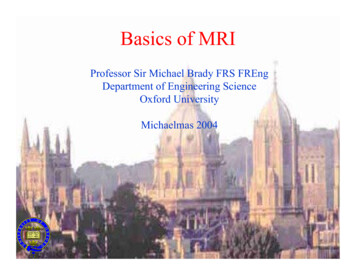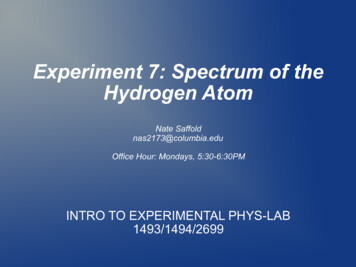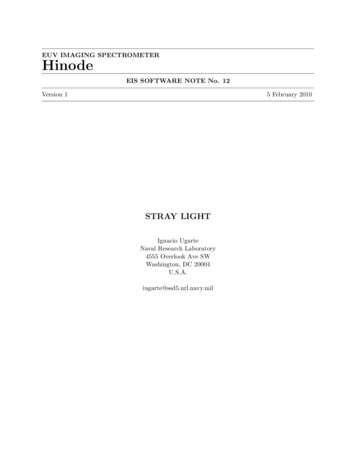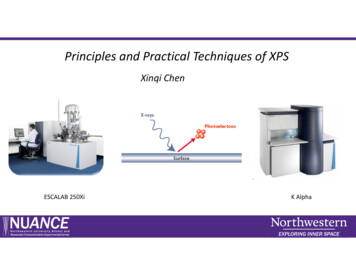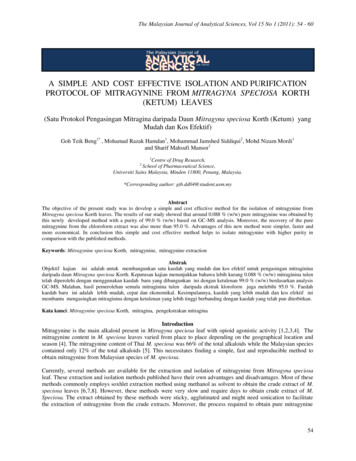![The GIANO-TNG Spectrometer [6269-46]](/img/1/spie-6269-46.jpg)
Transcription
The GIANO-TNG spectrometerE. Oliva,a,b L. Origlia,c C. Baffa,a C. Biliotti,a P. Bruno,d F. D’Amato,e C. Del Vecchio,aG. Falcini,a S. Gennari,a F. Ghinassi,b E. Giani,a M. Gonzalez,b F. Leone,d M. Lolli,cM. Lodi,b R. Maiolino,a F. Mannucci,a G. Marcucci,f I. Mochi,a P. Montegriffo,c E. Rossetti,cS. Scuderi,d and M. SozzigabINAF – Osservatorio di Arcetri, Largo E. Fermi 5, I-50125 Firenze, Italy;Telescopio Nazionale Galileo, calle A. de Abreu 70/1, E-38700 S.Cruz de La Palma, Spain;c INAF – Osservatorio di Bologna, via Ranzani 1, I-40127 Bologna, Italy;d INAF – Osservatorio di Catania, via S. Sofia 78, I-95123 Catania, Italy;e CNR – Istituto Nazionale di Ottica Applicata L.go. E. Fermi 6, I-50125 Firenze, Italy;f Università di Firenze – Dip. di Astronomia, Largo E. Fermi 5, I-50125 Firenze, Italy;g INAF – Istituto di Radioastronomia, Largo E. Fermi 5, I-50125 Firenze, ItalyABSTRACTGIANO is an infrared (0.9–2.5 µm) cross-dispersed echelle spectrometer designed to achieve high resolution,high throughput, wide band coverage and very high stability for accurate radial velocity measurements. It alsoincludes polarimetric capabilities and a low resolution mode with RS 400 and complete 0.75–2.5 µm coverage.This makes it a very versatile, common user instrument which will be permanently mounted and available onthe Nasmyth-B foci of the Telescopio Nazionale Galileo (TNG) located at Roque de Los Muchachos Observatory(ORM), La Palma, Spain.The project is fast-track and relies on well known, relatively standard technologies. It has been recognized asone of the top priority instrumental projects of INAF (the Italian National Institute of Astronomy) and receivedits first financing for the phase-A study in October 2003. Integration in the laboratory is planned to start beforethe end of 2006, commissioning at the telescope is foreseen within 2007 and scientific operations in 2008.One of the most important scientific goals is the search for rocky planets with habitable conditions aroundlow-mass stars. If completed on time, GIANO will be the first and only IR instrument operating worldwideproviding the combination of efficiency, spectral resolution, wavelength coverage and stability necessary for thistype of research.With its unique combination of high and low resolution modes, GIANO will also be a very flexible commonuser instrument ideal e.g. for quantitative spectroscopy of brown dwarfs, stars and stellar clusters as well as forthe determination of the spectral energy distribution of faint/red objects such as high redshift galaxies. Theexpected limiting magnitudes are such that GIANO will be able to deliver good quality HR spectra of any2MASS object and LR spectra of any object detected in the UKIDSS large area survey.Keywords: Ground based infrared instrumentation, infrared spectrometers1. INTRODUCTIONGIANO is a fast-track and relatively low-cost project for a high resolution near-IR (0.9–2.5 µm) spectrographwith superb spectral stability, very wide spectral coverage and the highest possible efficiency. The instrument willbe permanently mounted at a fixed position in the Nasmyth-B focal station of the Italian 3.58m TNG telescopeat the ORM observatory in La Palma.One of primary scientific targets is the search of rocky planets (down to a few Earth masses) around lowmass stars by means of accurate (few m/s) radial velocity measurements. Complementary to this highly specificscope, the instrument must also offer top-level observing capabilities of interest for the broad community ofsolar-system, stellar, galactic and extra-galactic astronomers who greedily access the TNG telescope.Ground-based and Airborne Instrumentation for Astronomy, edited by Ian S. McLean, Masanori Iye,Proc. of SPIE Vol. 6269, 626919, (2006) · 0277-786X/06/ 15 · doi: 10.1117/12.670006Proc. of SPIE Vol. 6269 626919-1
Table 1. Overview of GIANO observing modesObserving modeaHigh-res (HR)Shifted-High-res (SHR)dLow-res (LR)slit-lengthRS bspectral coverage (µm)6.5”6.5”30”23,00023,0004000.95 – 2.5c0.95 – 2.5d0.75 – 2.5Slit widths: 0.5” (2pix), 0.75” (3pix), 1.0” (4pix), 1.5” (6pix)abcdAll modes can be used with the polarimetric unitResolving power for 1” slitComplete up to 1.7 µm and 70% complete in the K bandAccesses the part of the 1.7–2.5 µm spectrum not visible in the HR modeThese apparently contradicting requirements are satisfied by the GIANO instrument which takes its namefrom the double-faced God of the ancient Romans. Its front face is that of high resolution (R 46,000 with a2 pixels sampling) cross-dispersed echelle spectrograph delivering a quasi complete 0.95–2.5 µm spectrum in asingle shot, while the back face shows a long slit low resolution (RS 400 and Rmax 1000) spectrometer covering the full 0.75–2.5 µm range with unprecedent throughput, hence ideal for the study of very faint continuumobjects. The instrument also includes a polarimetric mode optimized for high resolution observations, but alsousable in the low resolution mode.Detailed descriptions of the various sections of the instrument and of its software and acquisition system arepresented in separate contributions to this conference.1–7 In the following sections we discuss the instrumentalcapabilities, some of the most relevant scientific drivers and the scheduling of the works foreseen in the next twoyears.2. INSTRUMENT CAPABILITIES AND PERFORMANCESThe observing modes of GIANO are summarized in Table 1. The layout of the spectra in the high (HR) and low(LR) resolution modes are visualized in Fig. 1. The spectral range covered in the HR mode is complete up to 1.7µm and 70% complete at 2.45 µm. This compromise follows from the requirement of maximizing the resolvingpower without excessively decreasing the spectral coverage at the longer wavelengths. Nonetheless, the missingpart of the K band can be accessed in the “shifted high resolution mode” (SHR) which is obtained by insertinga thin prism in front of the echelle, i.e. without moving the grating.5On its way to the detector the light from the telescope passes through 11 refractive elements (i.e. 5 warmlenses, 3 cold prisms in double pass), it is reflected 16 times (5 warm mirrors and 7 cold mirrors, 4 of whichworking in double pass) and, in the HR-mode, it is diffracted by the echelle reflection grating. The overall opticalefficiency of the spectrometer and preslit system is therefore expected to be close to 60% in the LR mode and39% in the HR mode. The GIANO array, an HAWAII 2-PACE delivered in 2005, has a quantum efficiency of73% in K and 58% in J. Adding a conservative 75% efficiency for the telescope yields a total throughput inthe HR mode of 21% and 17% in K and J, respectively, while the figures for the LR mode are 33% (K) and26% (J). All these values are remarkably high. For the array noise we conservatively adopt a maximum on-chipintegration time of 20 minutes and a corresponding total noise of 17 electrons. These numbers are mostly basedon our direct experience with the NICS-TNG instrument which employes an HAWAII 1 array.The resulting limiting magnitudes for representative observing setups are listed in Table 2. It is interestingto note that the numbers for the HR mode are similar to the limiting magnitudes of 2MASS and DENIS, i.e.GIANO can provide high resolution spectra of any object detected by these surveys. Moreover, the sensitivitiesin the LR mode are well matched to the depth reached by the UKIDSS large area survey.Proc. of SPIE Vol. 6269 626919-2
Table 2. Expected limiting magnitudes for GIANO(1)HR mode, R 46,000 slit 0.5” seeing 1.0”Band S/N 100 in 1hr S/N 10 in 1hrJ12.215.3H11.814.9K11.214.1HR mode, R 28,000 slit 1.0” seeing 1.0”Band S/N 100 in 1hr S/N 10 in 1hrJ13.316.3H13.015.9K12.114.8LR mode, R 400 slit 1.0” seeing 1.0”Band S/N 100 in 1hr S/N 10 in 1hrJ16.519.1H15.618.2K14.717.3(1)S/N per spectral resolution element.2.1. Expected performances of GIANO for radial velocity measurementsCompared to the other (and indeed few) high resolution IR spectrographs available or under construction, GIANO is the only instrument offering an almost complete coverage of the spectrum in one shot. In other words,GIANO is the only IR spectrograph with spectral format and coverage comparable to optical instruments currently used for accurate radial velocity measurements.The photon-noise limit to radial velocity measurements scales with the instrumental resolution, the S/N ratioof the spectrum and the square-root of the effective number of usable lines (Nl ). In the specific case of GIANOσ(RV) 5 · (S/N) 1 · (Nl ) 0.5km/sThe cell adopted for GIANO is a combination of halogen hydrates which creates a clean and regular pattern ofroto-vibrational absorption lines distributed over most of the J, H and K atmospheric windows (see Fig. 2). Sincethe spectrum of late-M dwarfs is reach enough to have several stellar features within 10 resolution elements ofeach line of the cell reference spectrum, the effective number of useful lines is practically set by the depth anddistribution of the cell absorption features. This has not been measured as yet, but it can be quite accuratelypredicted3 because of the simplicity of the molecules and transitions involved. The only important uncertaintyis the exact quantity of gas which will be in the cell. As a conservative lower limit one can assume Nl 30, whileone can optimistically expect values as large as 200. The corresponding radial velocity accuracies are plotted inFig. 3 as a function of the stellar magnitude.3. SCIENTIFIC DRIVERSThe recent development of several IR spectroscopic studies is now facing a shortage of instruments working athigh spectral resolution and covering a wide spectral range. GIANO has the unique capability of spanning twoorders of magnitude in spectral resolution (from 400 to almost 50,000), to cover most the full near-IR spectralrange in one shot and to measure linear and circular polarization. These characteristics will allow to tackle withunprecedented accuracy several important astronomical issues.Proc. of SPIE Vol. 6269 626919-3
In the following some of the scientific cases which will be addressed with GIANO are listed, as gathered bya survey among several Italian groups. It should be noted that some of the scientific drivers discussed in thefollowing cannot be pursued (with the same degree of accuracy) with other existing or planned instruments, evenat 8–10m class telescopes. Extra-solar rocky planets.The capability of GIANO to simultaneously measure a huge number of near-IR features at high resolvingpower will make it the optimal tool in the search for low-mass, rocky planets around cool low-mass starswhich are too red for being observed at optical wavelengths. A particularly interesting aspect of this fieldof research is discussed further in Sect. 3.1. Star-forming regions.By studying the velocity structure of suitable emission lines in star-forming regions it will be possible toobtain fundamental information on accretion/ejection mechanisms in active protostars and on how theactivity of low mass young stars evolves from the embedded to the pre-main sequence phase. Cool stellar atmospheres.The unique combination of high spectral resolution, wide spectral coverage, polarimetric capabilities andhigh sensitivity will allow to derive with unprecedented accuracy the abundances of most atomic andmolecular species, the magnetic fields and the mass loss activity in any class of cool star. This informationis crucial for our understanding of the stellar physics, evolution and chemical enrichment. Black Holes in obscured AGNs.GIANO will allow to tightly constrain the Black Hole mass in several galactic nuclei which are too obscuredby dust to be probed by optical spectrometers. This is in particular the case for obscured AGNs, whichare largely the dominant population of active nuclei. IMF in starburst galaxies.By resolving the width of absorption and emission features in dust embedded Super Star Clusters (foundin starburst galaxies) it will be possible to tightly constrain their Initial Mass Function (IMF). Henceforth,it will be possible to investigate the dependence of the IMF on the level of activity and metallicity of thesesystems, which is highly relevant for our understanding of the formation and evolution of stellar systems. Damped Lyα Systems.GIANO will allow to measure the metallicity of high–z Damped Lyα systems by measuring the equivalentwidth of the associated absorption by various atomic species, which are shifted into the near-IR. This willallow to tightly constrain the metallicity evolution of Damped-Lyα Systems, which is currently poorlyknown because of the shortage of indicators in the optical at high redshift. Minor Bodies of the Solar System.The wide spectral coverage of GIANO in the low resolution mode will allow to detect various spectralfeatures of minor bodies of the solar system which will allow to unambiguously determine their composition,nature and origin. Obtaining this information on this class of objects will greatly help to understand theformation of the Solar System. Brown Dwarfs.It has been recently shown that a wide, continuous spectral coverage in the near-IR is the optimal tool forthe classification of very low mass stars and brown dwarfs. The capabilities of GIANO will not only allowa careful classification of these objects (using the LR mode), but will also allow to study the compositionof their atmosphere and their circumstellar activity.Proc. of SPIE Vol. 6269 626919-4
Extremely Red Objects.Identifying and understanding the nature of this class of high redshift objects (either dusty starbursts orellipticals) will greatly benefit of the wide spectral coverage and unique sensitivity of LR mode of GIANO.The spectra will allow to identify spectral breaks typical of the continuum of ellipticals at high redshift. Atthe same time the moderate spectral resolution will allow to detect emission lines associated to starburstactivity. No other instrument would allow for such a compl
S. Scuderi, d and M. Sozzi g a INAF Osservatorio di Arcetri, Largo E. Fermi 5, I-50125 Firenze, Italy; b Telescopio Nazionale Galileo, calle A. de Abreu 70/1, E-38700 S.Cruz de La Palma, Spain; c INAF Osservatorio di Bologna, via Ranzani 1, I-40127 Bologna, Italy; d INAF Osservatorio di Catania, via S. So a 78, I-95123 Catania, Italy; e CNR Istituto Nazionale di Ottica Applicata L.go. E. Fermi .




